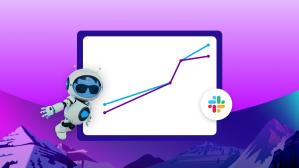When I joined Salesforce in early 2020 as Global Innovation Evangelist, my focus was helping companies accelerate digital transformation and innovation initiatives. The goal was to help executives explore the art of the possible and build companies of the future, step by step, today. Then the global pandemic changed the narrative of 2020, forcing organizations to suddenly respond to years of manifesting digital disruption all at once. Overnight, companies everywhere were faced with the unanticipated and overwhelming task of scaling infrastructure to support working from home, shift management, e-commerce, and digital/physical processes to supporting buying online and picking up in-store and deliver en masse. Unprecedented and uncertain don’t even begin to describe these times. There was no playbook for 2020.
We all had to learn how to react and move forward, aspiring for something greater and more significant than just a new or next normal. As a result, I dedicated the first year of my work to studying how COVID-19 was affecting customer behaviors, sentiment, and values. Doing so would help me better help executives make meaningful decisions now, during COVID, and also set the stage for post-COVID innovation.
The extent to which customers changed in 2020 is profound. Not only did they become digital first or at least digital-savvy, they were emotionally and psychologically affected by the fear, anger, and anxiety surrounding the pandemic and its effects on the economy and their livelihoods.
We reflected on life and reassessed our values and direction accordingly. We became more conscious in our decision-making. We became more demanding. We prioritized trust, community and the role we expect businesses to play in society.
Needless to say, our standards for marketing, sales, service, and loyalty elevated, too.
Now digital transformation evolves into a digital imperative with organizational and business model modernization and innovation more important than ever to compete beyond the uncertain times of today and tomorrow.
It’s time for businesses to accelerate digital initiatives as a matter of survival beyond the pandemic. Your customers demand it. In our State of the Connected Customer report, 88% of customers stated that they expect companies to accelerate digital initiatives.
With 2021 within our grasp, the need to digitize operations and experiences is critical. More so, the need to transcend digital into an organization centered around customers, with a 360 view and real-time engagement models, throughout the customer journey and lifecycle, is the purpose, and vital mission, of digital transformation in 2021.
As the year wraps up, and we look forward to 2021, I wanted to share three ideas I’m thinking about that will help businesses navigate the new year.
Designing experiences for the digital-first employee
Customers have become digital-first as a result of the pandemic, but we can’t forget that evolving customers are also evolving employees. The customer journeys and experiences they love are for a reason. They’re increasingly quick to leave behind the experiences that don’t meet their expectations or veer from their increasingly rising standards of engagement.
In the 2020 edition of the Salesforce State of the Connected Customer report, 84% of customers said the experience a company provides is as important as its products and services. Furthermore, 73% of customers revealed that one extraordinary experience raises their expectations of other companies And, 66% of customers are willing to pay more for a great experience.
We need to start connecting the dots from CX to employee experience (EX). The question for CHROs, managers, and most importantly, leaders, to answer is, what can we learn from industry-leading and innovative customer experiences? How can we apply user experience insights to our work, processes, and technology investments to inspire more intuitive, desirable, creative, and collaborative experiences and reimagine work? In 2021, EX becomes the internal equivalent of CX. Experience design for EX and CX becomes a competitive advantage and also a magnet for sought-after talent.
Experience innovation starts with digital-first customers
In 2020, the writing was on the wall, starkly, and unquestionable in its meaning, customers weren’t only becoming more and more digital-first, they were doing so because of shelter-in-place and for their own safety. In its Quickening research, McKinsey discovered that in the U.S. 75% of customers had experimented with another brand, website, or retailer in the early days of COVID-19 and that 60% committed to shift post-COVID. These numbers were similarly high around the world.
In 2021, businesses need to shift from the mere digitization and modernization of systems, processes, and journeys. To compete for the future, right now, takes becoming digital- and customer-centric, at the very core of the business itself. In the 2020 edition of Salesforce’s State of the Connected Customer report, the path forward became urgently clear. Eighty-eight percent of business customers and consumers expect companies to accelerate digital initiatives. They also demand new digital ways of getting existing products and services (69%), expanded touchpoints for engagement (54%), and new types of products and services, i.e. business model innovation (54%).
This your 2021 roadmap. Building an organization around the digital-first customer, a true 360-view, gets you closer to all customers, those you want to retain and those you need to attract to drive growth.
Hiring an AI futurist in the C-Suite
When we talk about the new or next normal, what does that mean? What does it look like? What are the scenarios we need to consider? In 2021 and beyond, executives must immediately consider whether they have qualified and capable resources at the ready to make fast, informed decisions, beyond survival and business continuity to navigate market shifts and guide the mid-to-long-term health of the organization. There’s an awful lot of unknowns to consider at a time when every decision counts more than ever.
Custom deep learning tools are available now, not just in labs, but in business applications. We see it, for instance, in Tesla’s semi-autonomous cars on the roads today. The Tesla network is constantly learning to improve the self-driving capacity and experience for every Tesla owner now and in the future.
For everyday organizations, specific AI solutions can be built upon neural networks and layers of nodes to process explicit data for desired outcomes at levels well beyond human capacity. This is the ideal time to promote AI to the C-Suite with the creation of a new role, the AI Futurist.
An AI futurist can accelerate the study of new data sets to serve as a digital advisor to executives around COVID-19-influenced scenarios and potential future scenarios. The idea isn’t to displace humans in this role. Instead, an AI Futurist would augment a specially created human task force consisting of scenario planners and economic, health, and tech experts to outline possible events and trends and to guide executives through these disruptive times.
An AI Futurist along human counterparts could help executives consider possible future scenarios unique to their data sets and interests to more effectively navigate uncharted paths forward today. Specifically, algorithms can be developed to model how COVID-19 and future unknowns can potentially affect markets, supply chains, productivity, sales, et al., to then focus considerations and investments for the best possible outcomes while mitigating risks.
These are just a few of the trends I’m following. I’m excited for 2021 and I’m already thinking about 2022. I look forward to sharing what’s next with you and more importantly, collaborating with you in the new year. To that, I say cheers and here’s to a less disruptive but more innovative, creative, and prosperous 2021!



















